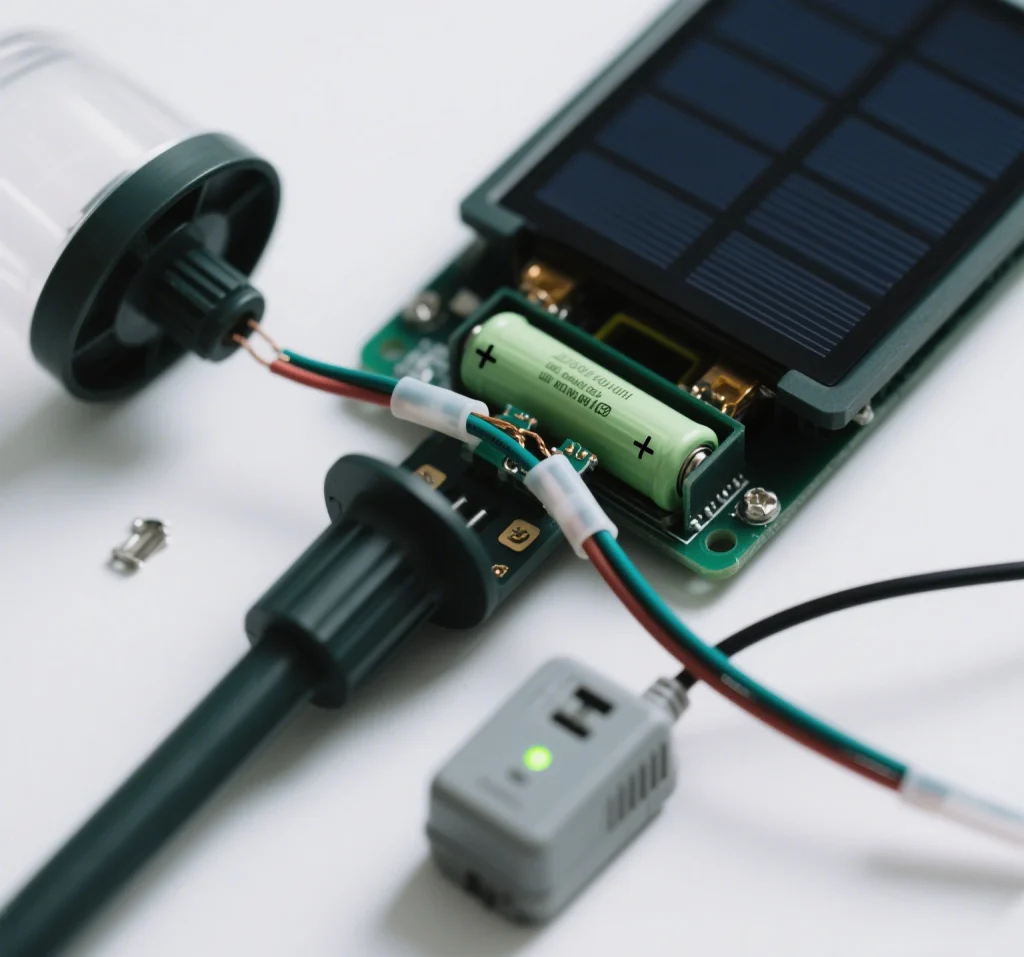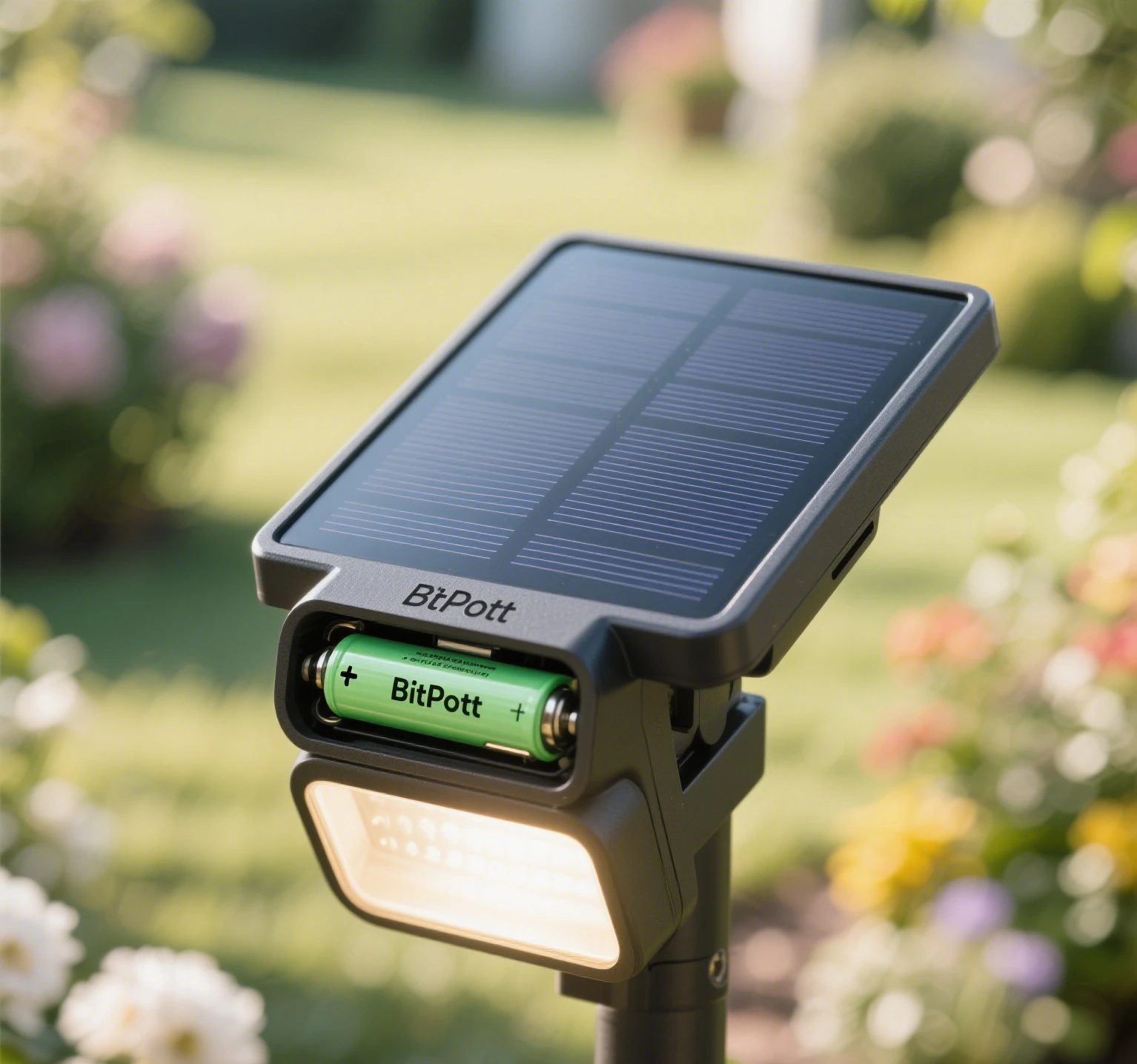Solar lights are a sustainable and cost-effective way to illuminate gardens, pathways, and outdoor spaces, but their performance hinges on choosing the right rechargeable batteries. Selecting compatible batteries for your solar-powered lighting can be tricky due to issues like voltage mismatch, battery size, or incorrect battery types. This article guides you through selecting rechargeable batteries that match your solar light specifications, addresses common mistakes like using the wrong battery type, and highlights versatile options like Bitpott batteries. We’ll also provide a step-by-step process to check compatibility and ensure optimal performance for your solar garden lights.

Why Compatibility Matters for Solar Light Batteries
Using compatible rechargeable batteries is critical for the efficiency and longevity of solar lights. Most solar-powered lighting systems use NiMH batteries (Nickel-Metal Hydride, typically 1.2V) or, less commonly, lithium-ion batteries (3.2V or 3.7V). A voltage mismatch—such as using a 1.5V alkaline battery in a system designed for 1.2V NiMH batteries—can lead to dim lighting, inconsistent performance, or even damage to the solar light. Similarly, battery size (e.g., AA, AAA, or 18650) must match the light’s compartment, as incorrect sizes won’t fit or connect properly.
Compatibility issues can also arise from mismatched capacity (mAh) or recharge cycles. For example, low-drain solar garden lights may work well with 600-1000 mAh batteries, while high-drain floodlights require 2000-2800 mAh. Choosing the wrong battery can reduce runtime or lifespan, wasting money and energy. By selecting compatible batteries, you ensure reliable solar-powered lighting and avoid common pitfalls.
Step-by-Step Guide to Choosing Compatible Batteries
To find compatible rechargeable batteries for your solar lights, follow this structured process based on industry best practices and manufacturer recommendations:
- Check the Solar Light Specifications
Review the user manual or product label for your solar light to identify the required battery type, voltage, capacity (mAh), and battery size. Most solar garden lights use AA NiMH batteries (1.2V, 600-2000 mAh), while some high-power models may use lithium-ion batteries (3.2V or 3.7V, 1000-3000 mAh). For example, Bitpott’s AA NiMH batteries (1.2V, 1100 mAh) are compatible with many standard solar lights. - Verify Battery Size
Confirm the physical size (e.g., AA, AAA, 14500, or 18650) matches the battery compartment. Using a battery size checker (available online or at hardware stores) can help. For instance, AA NiMH batteries are common in solar-powered outdoor lighting, but some compact lights use AAA. - Match Voltage Requirements
Ensure the battery’s nominal voltage aligns with the solar light specifications. NiMH batteries (1.2V) are not interchangeable with lithium-ion batteries (3.2V-3.7V) without a compatible circuit. A voltage mismatch can cause underperformance or damage. Check if the light has a built-in voltage regulator, which some modern solar lights include to handle slight variations. - Assess Capacity Needs
Choose a capacity (mAh) that suits your solar light’s power demands. Low-drain solar garden lights typically need 600-1000 mAh, while security or floodlights may require 2000 mAh or more. Higher capacity extends runtime but may increase cost. - Consider Recharge Cycles
Look for batteries with high recharge cycles (e.g., 1000-2100 cycles) for longevity. This is especially important for solar lights, which charge daily. Batteries like Panasonic Eneloop (2100 cycles) or Bitpott (1000 cycles) offer durability for frequent use. - Test Compatibility
After installing new rechargeable batteries, test the solar light over a few nights to ensure consistent brightness and runtime. If the light dims quickly, the capacity or battery type may be incompatible.
This process ensures you select compatible batteries that maximize the performance of your solar-powered lighting.
Common Mistakes to Avoid
Choosing the wrong rechargeable batteries can lead to frustration and reduced solar light performance. Here are common errors and how to avoid them:
- Using Alkaline Batteries: Disposable alkaline batteries (1.5V) are not designed for solar lights, which rely on NiMH batteries or lithium-ion batteries for daily charging. Alkalines can leak or fail prematurely, damaging the light.
- Ignoring Voltage Mismatch: Installing a 3.2V lithium-ion battery in a 1.2V NiMH system can overload the circuit, causing flickering or failure. Always verify voltage requirements.
- Mismatching Battery Size: Using AAA batteries in an AA compartment or vice versa prevents proper connection. Double-check the battery size specified by the manufacturer.
- Overlooking Capacity: Choosing a 600 mAh battery for a high-drain solar light like a floodlight will result in short runtime. Match capacity (mAh) to the light’s needs.
- Using Low-Quality Batteries: Cheap, unbranded batteries may have inconsistent recharge cycles or poor performance in temperature extremes, common in solar-powered outdoor lighting.
By avoiding these mistakes, you can ensure your solar lights operate efficiently and last longer.

Bitpott: A Versatile and Compatible Option
Bitpott’s AA NiMH batteries (1.2V, 1100 mAh, 1000 recharge cycles) are a versatile choice for many solar lights, particularly low- to medium-drain solar garden lights. Their standard AA battery size fits most common solar-powered lighting models, and their voltage (1.2V) aligns with the requirements of typical NiMH-based solar lights. Priced at $0.80-$1.20 per battery in bulk, Bitpott offers an affordable solution for users replacing batteries in multiple lights, such as pathway or decorative setups.
Bitpott batteries are designed to handle the daily charge-discharge cycles of solar lights, with good performance in temperature fluctuations (from -4°F to 122°F). While they have fewer recharge cycles than premium brands like Eneloop, their compatibility and cost-effectiveness make them a practical choice for budget-conscious consumers.
Comparing Common Battery Types for Solar Lights
| Battery Type | Voltage | Capacity (mAh) | Battery Size | Recharge Cycles | Best For |
|---|---|---|---|---|---|
| NiMH | 1.2V | 600-2800 | AA, AAA | 1000-2100 | Most solar garden lights |
| Lithium-ion | 3.2V-3.7V | 1000-3000 | 14500, 18650 | 500-1000 | High-drain solar lights (e.g., floodlights) |
Key Takeaway: NiMH batteries are the most common and compatible batteries for solar-powered lighting, offering a balance of voltage, capacity, and recharge cycles. Lithium-ion batteries are suited for specialized, high-drain applications but require careful compatibility checks.
Addressing Voltage and Size Mismatches
Voltage mismatch is a frequent issue in solar lights. For example, replacing a 1.2V NiMH battery with a 3.2V lithium-ion battery can damage the light’s circuitry or cause inconsistent performance. To avoid this:
- Use a multimeter to measure the voltage of the original battery if the manual is unavailable.
- Check for labels inside the battery compartment indicating NiMH or lithium-ion compatibility.
- Consult the manufacturer’s website for solar light specifications if the model number is known.
Battery size mismatches are equally problematic. AA and AAA NiMH batteries are standard for most solar garden lights, but some modern lights use lithium-ion formats like 18650. Always measure the compartment or refer to the manual to confirm the correct battery size.
Practical Tips for Ensuring Compatibility
- Read the Manual: Always start with the solar light’s user manual or product listing to confirm battery type, voltage, and battery size.
- Check Online Databases: Websites like SolarReviews or manufacturer portals often list compatible rechargeable batteries for specific solar light models.
- Use Reputable Brands: Trusted brands like Panasonic Eneloop, Tenergy, or Bitpott ensure consistent voltage and capacity, reducing compatibility issues.
- Test with a Single Battery: Before replacing all batteries, test one compatible battery to confirm performance in your solar light.
- Upgrade Chargers: Use a smart charger designed for NiMH batteries or lithium-ion batteries to prevent overcharging, which can affect compatibility over time.
Why Choosing Compatible Batteries Matters
Selecting compatible rechargeable batteries enhances the performance and lifespan of your solar lights. Properly matched batteries ensure consistent brightness, longer runtime, and fewer replacements, saving money and reducing waste. For example, using Bitpott’s AA NiMH batteries in a compatible solar garden light can provide reliable illumination for 3-5 years with proper care. In contrast, incompatible batteries can lead to frequent failures, increased costs, and environmental harm from improper disposal.
Conclusion: Power Your Solar Lights with Confidence
Choosing compatible rechargeable batteries for your solar lights is essential for optimal performance and sustainability. By following our step-by-step guide to check solar light specifications, verifying battery size, voltage, and capacity, and avoiding common mistakes like voltage mismatch, you can ensure your solar-powered lighting shines brightly. Versatile options like Bitpott’s NiMH batteries offer affordability and compatibility for most solar garden lights, while brands like Eneloop and Tenergy cater to diverse needs. Invest in compatible batteries today to power your solar lights efficiently and sustainably.

Comments